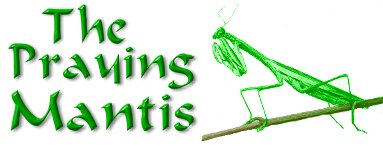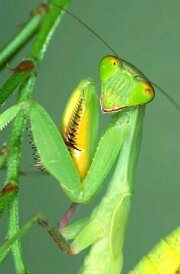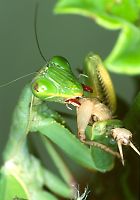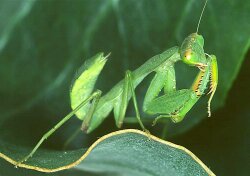
The Praying Mantis gets its name because, while waiting for food to come by, it holds its long front arms as if it is praying.
The mantis is a very useful insect to have in your garden; it eats flies, caterpillars, grasshoppers, roaches, and other pests. But if you are a beekeeper, watch out ... the praying mantis will sit at the entrance to the hive and devour bees one by one as they go in and out! Mantises have no sting or venom; they hold on to their victim and eat it alive, bit by bit.
If you see a mantis, you may be startled by its aggressive behaviour. It will stand up and buzz its wings at you. But that's only because it's trying to scare you off; the Praying Mantis is completely harmless to humans.
|

|

|
An adult mantis can grow to be as much as 10 centimetres long. It uses its four back legs to walk around on, and the two long legs in front, with their thick saw-like claws, are used as weapons, and to grab food as it wanders by.
The mantis has excellent vision, and often will stalk its prey like a cat before pouncing. Its strong lower mandible helps it to pull its meal apart.
The mantis is one of the few insects that can turn its head. If you ever pick one up, you'll be startled by how it will swivel its head around to watch you.
|
The mantis at the right can be seen cleaning its front legs after a meal. Mantises seem to be very fastidious in their cleanliness, and also seem to show curiosity about what's going on around them. They have been kept as pets for thousands of years.
|

|
Resources
HTML, graphics & design by Bill Willis 2023
|